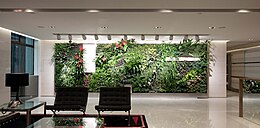it's actuallmore natural than with soil.
the selection of plants is bassed on several factors:
1.what's the local clymates
2.how much sun exposure the surface.
3.is there any particular micro clymates?
4.such as high buildings creating strong wind along wall
etc
the concept of it dates back to 600BC with the hanging garden of babylon.
the larger vertical garden concept has been utilized with innovative hidroponic tecnology.
There are two main categories of green walls: green façades and living walls. Green façades are made up of climbing plants either growing directly on a wall or, more recently, specially designed supporting structures. The plant shoot system grows up the side of the building while being rooted in the ground. With a living wall the modular panels are often made of stainless steel containers, geotextiles, irrigation systems, a growing medium and vegetation.[3]
There are three types of growth media used in living walls: loose mat,mat media ,and structural media.
Function
Green walls are found most often in urban environments where the plants reduce overall temperatures of the building. "The primary cause of heat build-up in cities is insolation, the absorption of solar radiation by roads and buildings in the city and the storage of this heat in the building material and its subsequent re-radiation. Plant surfaces however, as a result of transpiration, do not rise more than 4–5 °C above the ambient and are sometimes cooler."[6]
Living walls may also be a means for water reuse. The plants may purify slightly polluted water (such as greywater) by absorbing the dissolved nutrients. Bacteria mineralize the organic components to make them available to the plants. A study is underway at the Bertschi School in Seattle, Washington using a GSky Pro Wall system, however, no publicly available data on this is available at this time.
Living walls are particularly suitable for cities, as they allow good use of available vertical surface areas. They are also suitable in arid areas, as the circulating water on a vertical wall is less likely to evaporate than in horizontal gardens.
The living wall could also function for urban agriculture, urban gardening, or for its beauty as art. It is sometimes built indoors to help alleviate sick building syndrome.




















.JPG)






.JPG)















0 komentar:
Posting Komentar